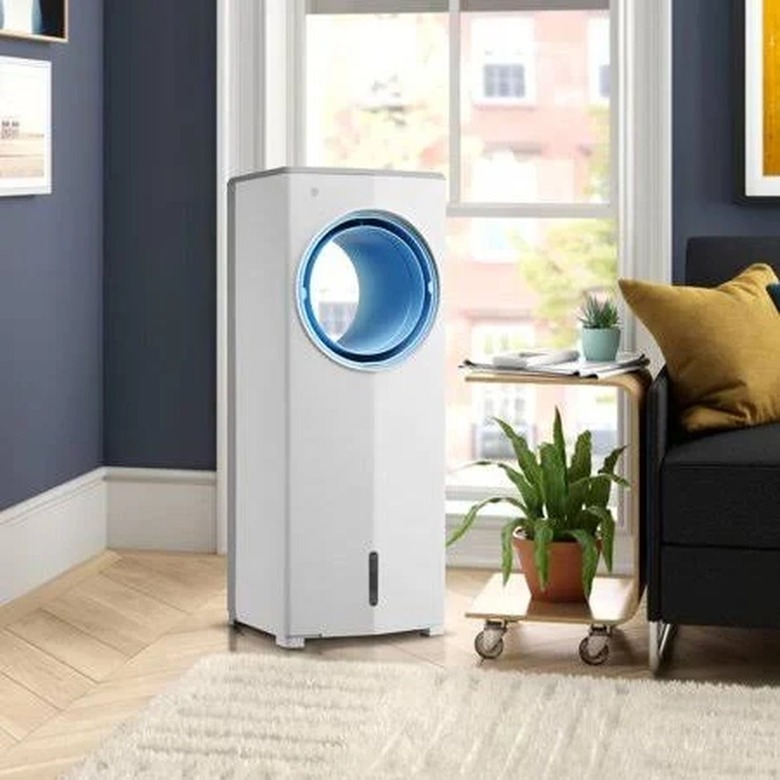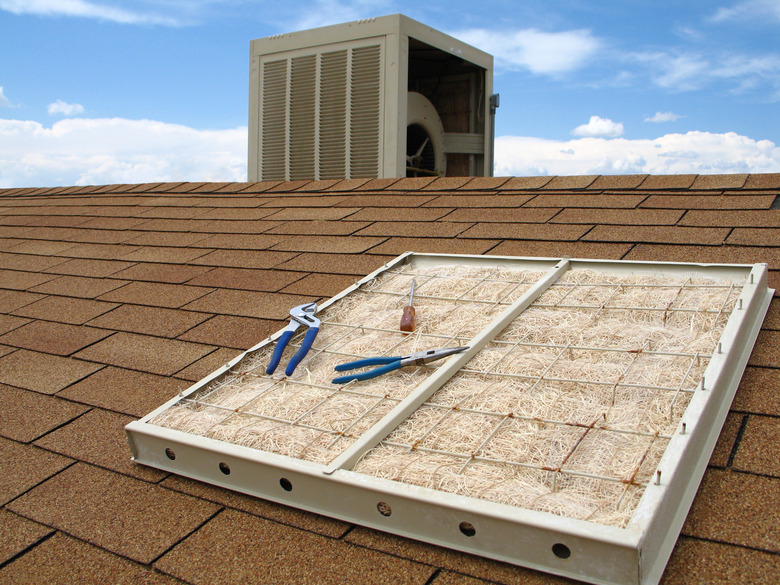How Do Evaporative Coolers Work?
An evaporative cooler is a cost-effective, energy-efficient alternative to an air conditioner for homeowners who live in hot, dry climates, and it uses the same basic principle to cool the air: evaporation. Whereas air conditioning systems rely on the evaporation of a refrigerant inside a closed system of tubing, an evaporative cooling system is open to the atmosphere and needs no compressor. Water drips through cooler pads, and the airflow created by a blower turns hot air into cool air that can be circulated into the living space.
It's common to refer to an evaporative cooler as a swamp cooler. That term really applies only to rooftop units, but it serves as a reminder of the number-one drawback of evaporative cooling. Used in the wrong climate, an evaporative cooler can create swamplike conditions that can actually make a hot home feel hotter. In the right climate, however, an evaporative cooling system can reduce the indoor air temperature by as much as 20 degrees, which makes a big difference on a hot day.
Tip
An evaporative cooler blows warm air through a cooling pad saturated with water, and as the water evaporates, it cools the air, which then circulates indoors.
How Evaporative Coolers Work
The fact that water evaporation has a cooling effect is well known to anyone who has a body — because that's why people sweat. Anyone who needs an additional demonstration of the cooling effect of evaporation can simply soak a towel with hot water and hold it in front of a fan. The hot water and the towel quickly become cold, as does the air coming through the towel.
Cooling happens when water evaporates because the water molecules need energy to break the bonds that hold them together as a liquid, and they take this energy from the surrounding air. In this way, evaporation doesn't so much cool the air as it does make the air less warm, which is a small but significant difference. This is why evaporative coolers don't work well in humid air — because the water molecules that are broadcast into the air as vapor add more humidity, and when the air is saturated with moisture, the body's natural cooling mechanism doesn't work as well. Adding moisture also helps promote the growth of mold and mildew, which thrive in high humidity conditions.
What's Inside an Evaporative Cooler?
Unlike an air conditioner, which needs a compressor to pressurize refrigerant into a liquid so it can evaporate, an evaporative cooler just needs a source of water, a pad through which the water can circulate, and a blower to circulate fresh air through the pad to produce cold air. The blower in a portable evaporative cooler is just a fan, but a large rooftop unit needs one that more resembles the blower in a conventional forced-air HVAC system. It's typically a lightweight metal drum mounted on a horizontal axis and powered by a motor that consumes about 500 watts of electricity.
An evaporative cooler also needs a water supply. While portable units have removable tanks that you fill manually, fixed units are typically connected to a water supply by 1/4-inch or larger tubing. The water supply tube can spray water directly onto the cooling pads, but more often, it fills a pan at the bottom of the unit, and an internal water pump circulates the water to the top of the cooling pads. A float valve similar to the one in a toilet tank shuts off the water when the pan is full and prevents overflows.
What's Involved With Installation?
Portable evaporative coolers need no installation, and window units capable of cooling a single room are as easy to install as window air conditioners. Side-draft units that mount on the outside wall and down-draft units that mount on the roof typically require a professional to install them, primarily because they need water supply tubing and ductwork if they are to cool more than a single room.
Existing ductwork that serves a central air system usually isn't suitable for an evaporative cooler because it often contains sharp bends that allow moisture from the cooler to condense on the side walls, and that creates two problems. The first is that condensation, being the opposite of evaporation, releases heat and makes the air warmer. The second is that moisture inside the ducts promotes mold growth, which creates musty odors and other issues with air quality. Besides that, if the cool air has to travel a long way through a ductwork system, it won't be cool when it comes out of the registers. This all means that you'll need to get a professional to install new ductwork that's appropriate for an evaporative cooler.
Ideally, the ductwork from an evaporative cooler extends from the cooler to a diffuser mounted at a central location in the building in as straight a line as possible. To maximize the airflow, which is measured in cubic feet per minute (cfm), the duct from a wall or rooftop unit is larger than a central A/C duct, typically having a diameter from 18 inches (for coolers supplying 4,500 cfm or less) to 24 inches (for coolers supplying 6,500 cfm or more). Rigid duct is best, but many installers use flexible duct.
Cost of Evaporative Cooler Installation
The cost to install an evaporative cooler includes the cost of the unit itself, the cost of the ductwork, and the labor charges. The cost of a rooftop unit starts at about $600 and can be as much as $2,000 for a large house, while side-mount units are slightly less expensive. You can also choose an indirect evaporative cooler, which has a more complex design that includes a heat exchanger to help keep humidity levels down, and the cost can be as high as $6,000.
The ductwork isn't as extensive as the ductwork for central air conditioners, and since it extends straight from the cooler to the diffuser and doesn't have to be routed behind walls or under floors, it costs less to install: from $400 to $900 is typical. At the end of the day, you can expect to pay anywhere from $1,000 to $7,000 for installation of a whole-house evaporative cooler, including labor.
Who Should Consider Evaporative Coolers?
Evaporative coolers work best in dry regions in which the relative humidity is low — the best places being west of the Rocky Mountains and a few miles inland from the Pacific Ocean. In a region with an average relative humidity of 25 percent, a swamp cooler can reduce indoor temperatures by as much as 20 degrees, but in a region with 50 percent humidity, the temperature reduction might not be more than 8 degrees, although cooling efficiency does increase somewhat with air temperature. The drier the air, the more cooling you get from evaporative air, so people living in humid climates east of the Mississippi River are generally better off with an air conditioning unit.
If you're considering installing a swamp cooler on your roof, you should be aware that it will require more maintenance than an air conditioning system. The drain pan, cooling pads, and internal hoses are all subject to buildup of hard water deposits and mold, and they need to be cleaned regularly. However, there is one advantage to the evaporative cooling process: Cool air circulates better if you leave some windows open, so because you don't have to seal your house as tightly as you do if you have an air conditioner, you have more fresh air to breathe.
References
- Newair: What Are Evaporative Coolers? Here's Everything You Need to Know
- Perfect Home HVAC Design: Swamp Cooler Tech: Installation Recommendations for the Homeowner or Do-It-Yourselfer
- Energy.gov: Evaporative Coolers
- Fixr: How Much Does It Cost to Install a Swamp Cooler?
- Newair: When Should You Buy an Evaporative Cooler? Know Your Humidity Levels [Infographic]

